- Recently I hear many theater professionals in Japan saying that they have met you, Mr. Cho Kyung-Hwan. I also hear that you are quite fluent in Japanese. Have you visited Japan often?
- In recent years, I believe I have been visiting Japan about ten times a year. I often go at my own expense, and because I have my day job, I usually go to Japan on weekends on a two-day and one-night, or maybe three-day and two-night schedule, making the rounds of the country’s public theaters and arts centers. Sometimes I will meet with the theaters’ directors, but sometimes I just stop for a look at the facilities. Visiting these theaters and facilities is inspiring because I often meet fellow professionals who are thinking hard about what a public arts facility can do and working hard to realize their schemes. Also, this travel time gives me valuable time to concentrate on thinking about my job and get my thoughts together.
- How is it that you came to visit Japan so often?
-
At university and in graduate school my major was film, and my graduate thesis was about Korean film during the period of forced occupation [colonization] of the Korean Peninsula by Imperial Japan (1910-45). A lot of the historical material and records of this period were in Japan. So, even though you can see the colonization of Korea as historical destiny, I still had to win my own personal battle with Japanese culture as part of my studies. As a result, I spent two of my graduate school years studying comparative film history at [Tokyo’s] Nihon University from 1985. My specialty was [film director] Yasujiro Ozu. During this period of study in Japan, I often went to see films at the Iwanami Hall and so on, and that period left a vey strong impression on me, in terms of what you might call the theater mentality and what I came to see as the mission of theater and film in a culture. This experience is the starting point of my relationship with Japan.
Since becoming a theater manager myself, I have received inspiration from the writings of Hiroyuki Shimizu and Kisei Ei, and when I was working as administrative director of the Gwacheon Hanmadang Festival, I became familiar with the people at the Black Tent theater company, through whom I became interested in the activities of Makoto Sato in the public theater sector. - What prompted your shift from film to theater management?
-
After graduating, I worked for the cultural projects departments of corporations doing things like displays and video presentations, and when I was working for the Doosan Group they were soliciting applicants from within the company for the job of director of the Yongan Hall (present Doosan Art Center) that the company ran. I applied and was selected for the job. I was 33 when I began working in theater management in that way, and that made me the youngest theater director in South Korea. After working there for about six years, I began working as chief of the planning team at the National Theater of Korea in Seoul in 2000. While working there, however, I began to feel the limitations of a public theater, and I still had a longing to be involved in film production. So I quit that position after a year and returned to the movie world as a member of the Board of a movie company. But, during the time I had been away from the film world, it had changed a lot and I wasn’t able to find myself a place in it.
Then, in 2003 I returned to the performing arts world as administrative director of the Gwacheon Hanmadang Festival, and then I began working as head of the performance planning team for the Ansan Culture & Arts Center that opened in October of 2004 in Ansan City, Gyeonggi-do Province. This was a big turning point in my career. Ansan in one of the major industrial centers in S. Korea, with large industrial parks and many foreign workers living in the area. For these reasons it was often referred to as a cultural wasteland, and many of the resident’s had a complex about this area they lived in. And, this was the type of community that the new theater complex with three theaters ranging in seating capacity from 200 to 1,500 was opening in. Working at this theater facility presented me with the opportunity and the need to think seriously about what forms public theater should take and put me face-to-face with the questions of what it means to be “public.”
It was while I was struggling with these questions that I found keys for some of the answers in the writings of Hiroyuki Shimizu and Kisei Ei and the presence of public theaters in Japan like the Setagaya Public Theatre. At that time I was making frequent visits to Japan. Until now I have visited about 400 arts centers around the world and I have felt that there is a lot to be learned from Japan’s public theaters and the systems under which they are operated.
It has been in the process of thinking about the meaning of “public-ness” and the role of the public theater facilities, and the process of trial and error I have been through in search of meaningful public theater programs, that made me decided to make community-based theater management my life work. Working at Ansan Culture & Arts Center, through efforts like launching South Korea’s first program of citizen festivals for the four seasons and successfully creating a repertoire of the Center’s self-produced works, I was able to see gradual changes in the attitudes of the local citizens and their lifestyles. These achievements were then recognized in the form of the Excellent Organization Award and the Excellent Individual Achievement Awards of the Korean Cultural & Arts Centers Association that the Ansan Culture & Arts Center and I won in 2006, and the Grand Prix of Theater Program Management of the Innovative Competition we won in 2008. - When did you become involved with the Bupyeong Arts Center?
-
The land the Bupyeong Arts Center was built on originally belonged to the Ministry of National Defense and was sold as a large lot to the Bupyeong Ward. While deliberations were being made about how to use the land, a proposal was put forward to build public theater. Bupyeong Ward is one of the eight Wards of Incheon City and, even though it has a population of 570,000 residents, there are no culture facilities, only the small community centers of each neighborhood. The decision was made to begin construction on the theater in 2007 and, due to my achievements at Ansan, I believe, I was selected to serve on the project’s advisory committee from 2009.
The civil servants from the Ward office working on this project were truly dedicated and they knew their city’s residents well. At first there were some objections voiced regarding the construction of the theater, but after some repeated benchmarking and studying the comments from the residents, we were able to reach consensus to go ahead with the project. With the start of construction approaching, there was a call for applications for the position of center director, so I applied. I did so because I wanted to use this as an opportunity to realize my dream and give form to my beliefs about what a public theater could be. - I am told that Bupyeong Arts Center was the first public cultural facility in South Korea to adopt a BTL (Build Transfer Lease format where the facility is built with funds from the private sector to be leased to the public sector for a given period of time, during which the private sector financers recover their investment through the lease payments and then transfer ownership to the public sector once the lease period is over.) How was this carried out?
-
It was carried out as a joint project between Incheon Metropolitan City and Bupyeong Ward. Administrative management is done by the Bupyeong Arts Foundation established in 2006. The construction of the facility was done on a Build Transfer Lease basis with a construction cost of approximately 40 billion won (Approx. US$ 33,400,000)
(*1)
and was carried out by a private sector enterprise at the request of Bupyeong Ward and under the agreement that the facility would be leased by the public sector from the private sector enterprise for 20 years after the facility opened to repay the enterprise for the cost of construction. Normally a project for a facility like ours would be handled as an arts/culture infrastructure project by Incheon Metropolitan City and the national government, but the sheer size of the initial investment and the fact that Bupyeong Ward was active in proposing the construction of this new facility, an arrangement was made under which the national government would pay 100 million won (Approx. US$ 83,400 and Incheon Metropolitan City and Bupyeong Ward would each contribute a set amount annually as facility cost to pay the lease fee through the Center. In this sense, you can say that the national government, Incheon Metropolitan City and Bupyeong Ward are sharing the cost of construction, by for the national government and Incheon Metropolitan City it is only an investment in arts/culture infrastructure, while the management is left up to Bupyeong Ward, and under this system Bupyeong Ward is responsible for the annual operating costs. This was the first such attempt by a local government creating an arts/culture facility using the BTL forma in South Korea. I have heard that now Andong and Gimpo are also using this format to open new facilities.
As a result, our Arts Center has to make monthly lease payments from the facility budget we get from the national government, Incheon Metropolitan City and Bupyeong Ward and the Center’s operating revenue. Normally, public arts/culture facilities are thought of as facilities that are run from the art/culture budgets of the local government, but in our case the concept is not depending entirely on public funding but operating on the premise that the facility itself is part of our operating cost. Because this is our opening year, we have received a budget from Bupyeong Ward of 3.6 billion won (Approx. US$ 3 million) and we forecast independent income of 1.5 billion won (Approx. US$ 1.25 million), but going forward we plan to register as a Special Arts Organization (*2) to facilitate getting grant money while also making efforts to increase our independent income to the point where the breakdown of our operating expenses will be 70 percent from Bupyeong Ward public funding and 30 percent from the theater revenue. - That certainly is a valiant undertaking. It is also a plan that sounds like it could change the concept of what a public theater can be.
-
I want to create a new kind of public theater that takes the best aspects of both private-sector theaters and public theater. To realize that aim, our mission at the Arts Center includes achieving public-minded operation, business-like management and proficient and specified arts management. I believe it is the same for all such ventures but in order to win the consensus of the public it becomes a question of how the public’s tax money is being used and what results we can show for the investment. In South Korea until now we have had a bubble situation where extravagant theater facilities have presented extravagant programs of performances, but at our Arts Center we made a start that trims away that extravagance as much as possible.
Our Center has three theaters, an exhibition gallery, communication spaces, etc., and we have a staff of just 16 including our technical staff, and we also have 5 interns working with us. But it won’t be too late to increase our staff when we get a consensus from the residents of Bupyeong. And instead, we will be more than willing to invest in other areas that the residents feel are necessary. For example, at the HoBAC (Heart Of Bupyeong Arts Community) communication space that can indeed be called the heart of the Bupyeong Arts Center, the lights are always on, even when there is no one there, and there is always pleasing music playing in the lobby and other parts of the facility. The purpose for this that we want the public to always feel at ease using the facility.
Service is another area of concern for us. Although we usually wear causal clothes when we work, I and all the rest of our staff always wear our uniforms when guests (audience) come for a performance or other events. Before our facility opened we had all of the staff experience receiving guests at theater events and take part in training. Also, the staff in the parking lot, which is likely to be the first point of contact for visitors to our Center, and all the other staff are encouraged to greet each other with smiles as part of the important task of creating a pleasant working environment. Because the state of mind of the employees also has an effect on the audience. We want to be a theater where we are concerned about the welfare of every employee.
Korea’s public theaters have a lot of rules limiting the behavior of the audience, such as forbidding them to bring congratulatory or fan bouquets to performances, but at our theater we try as much as possible to break out of this pattern and create an environment can enjoy performances in a more relaxed and free atmosphere. - Could you please tell us about the theater facilities of your Center?
-
We have three theaters, the Hae-Nu-Ri (Sun) 893-seat large theater, the Dal-Nu-Ri (Moon) 339-seat theater and the rooftop outdoor performance hall Byeol-Nu-Ri (Star). We have the Kot-Nu-Ri (Flower) gallery space and the community hall HoBAC with a library that anyone can use freely and we have a studio and seminar room, a children’s playroom and an infant nursing room. The suffix
Nu-Ri
in the names of all these facilities means “shared by all.” The theme we chose from among the submissions to a open contest was to be an art center that aspires for “art for all.” Part of the Kulm Madan (Cloud) square outside the theater is planted in grass so that local residents can stroll or spread out a picnic lunch or children can play there. Once when I visited the Piccolo Theater in Hyogo Prefecture, I saw students practicing guitar outside the theater. I felt at the time that this is truly a public theater. I would like our Arts Center to be a space where students and local residents can gather to practice or give concerts, and I hope that the residents of Bupyeong will join in making it that kind of theater.
In October of this year the “Art Village” will open as a residency facility. The facility can house five artists in residence and it is my hope that we will see works born here that will be true products of Bupyeong or Incheon localities.
And, although this doesn’t have anything to do with facilities, we have established franchise companies, which is another first in South Korea. For this franchise we chose from the Incheon-based theater and dance companies the Ten Years Later Theater Company and Kubo Tanztheater. When we look at the Bupyeong as a community, we decided that rather than establishing our own company, it would be more advantageous from a number of perspectives to foster franchise companies. First of all, it would less of a financial burden and it would also provide a driving force for outreach programs. - Would you tell us about your Center’s management policies and the programs you have?
-
The motto of the Bupyeong Arts Center is “Art for All.” The arts and culture and arts and culture facilities are not something that belong to a chosen few. Bupyeong Ward is a suburb within a one-hour commute to Seoul. About 300,000 of residents commute to jobs outside the community, and about 270,000 of these residents have lived in Bupyeong for 20 to 30 years. Also, 30 percent of the population has never had significant contact with the arts and it is a realm that is alien to them. So our job has been to think what we need to do for residents who have lived here in Bupyeong for a long time and have not had opportunities to have contact with the arts.
The first things we planned in that light with the aim of increasing opportunities to encounter the performing arts easily and helping people become involved in them were a free-admission outdoor performance festival and low-priced-admission music, theater and children’s theater performances. The free-admission outdoor performance festival was something we planned originally as part of the Bupyeong Arts Center’s opening events, with a scheduled date of April 3rd this year. But just a few days before the festival was scheduled, the South Korean navy patrol ship Cheonan was sunk [by North Korea] and everyone in South Korea was in a gloomy mood, which didn’t seem to us to be a very good environment for celebrating our facility’s opening. So, we decided to move it back to July. Despite that sudden change, some 20,000 people turned out for the festival.
Bupyeong Ward is close to the capital, Seoul, so it is rather meaningless if we try to do the same things as theaters in Seoul are doing. That is why we plan our programming with a true focus on the people of our community. But that doesn’t mean that everything we present is popular culture aimed at the common citizen’s taste level. If we became a nondescript theater that only presented run-of-the-mill popular fare, that would also be meaningless, because that would not make us a theater that the local community could take pride in. Showing the people the appeal and interest of truly high-level performing arts is also an important role of the public theater, we believe.
In any case, the work is tough for the Center’s employees. The publicity aspect of our work would probably be much easier if we were presenting famous shows with big stars performing, but that is rarely the case, so we have to work hard with grassroots efforts to bring in a good sized audience. But we believe that those efforts can also be a form of communication with the residents of our community and a way to build an audience that loves the Bupyeong Arts Center. I believe that the ultimate goal of a public theater is to win the support of the public through involvement in the performance programming that raises the level of satisfaction in all of the cultural, welfare and health aspects of the things we do.
Besides presenting performances, we also offer our community programs like backstage tours, an academy program to help train stage professionals, citizen-participation theater classes, courses in art, music, literature and film, etc. and life-culture classes in subjects like art books and patchwork quilt-making. In all we have about 40 arts education and lifelong learning programs. Traveling around the world to visit arts centers in many countries has made me think a lot about the role we can play as a place for lifelong learning. I believe that there is a strong possibility that these kinds of educational programs will become the foundation of communication between the theaters and the communities. In this regard, we are offering not only professional training and theater education but also programs targeted at housewives, youth and the elderly.
These multi-layered programs will build the image of Bupyeong Arts Center and give it a distinct character that will differentiate it from other public theaters, and hopefully we will see the community’s unique character be re-produced through the cultural activities that go on here. I think this is one of the issues that other public theaters with their homogenous image have to deal with in the future. - The idea of trying to manage your theater as a community-rooted facility that operates on the same eye-level as the residents of Bupyeong Ward is certainly a fresh and inspiring one, but what about other public theaters besides yours in South Korea today?
-
South Korea is now said to in the “era of 637 arts centers.” There are now 637 national, public and private sector facilities with theaters nationwide, and of these, more than half were opened since 2000. In April, we held an international symposium at our Community Hall HoBAC titled “The Path Public Art Centers Should Take in the Era of 637 Arts Centers” and as speakers we invited from Japan, Hiroshi Watanabe, the programs director of the Saitama Arts Foundation and Mitsuhiro Yoshimoto, Senior Consultant for Arts and Cultural Projects of the NLI Research Institute. This symposium revealed that while there has been a rapid expansion of the hardware aspects of the arts/culture infrastructure in the form of arts centers and public theaters, we are now faced with the issues of the software aspects dealing with the questions of what it means to be a public institution, what the role of these public facilities should be and what management systems are necessary that have not kept pace with this that rapid growth. At the same time, while there are certainly differences in character of the different regions and the demographic makeup of the communities that make possible a variety of different forms of public theaters, but the problem of how to make a public theater fit its community is something that we all must find answers to.
In the Bupyeong Arts Center’s case, I believe it is fitting for it to be a facility by the people and for the people of this community, and I want us to be a facility that the residents of the community can be proud of and feel close to. When I visited the Saitama Arts Theater, I heard a story that the people at a noodle shop just a few blocks from the theater told visitors looking for the theater that they didn’t know where it was. I want ours to be a theater that people in the community will gladly guide outside visitors to. Right now, myself as director and my staff are managing the facility and its programs, but I believe that we will become a public theater in the true sense of the word when eventually the people of the community take an interest and begin gathering at the Center and shaping its programs.
At our Community Hall HoBAC, we will continue to hold seminars and symposiums about public theater actively. I believe that these efforts will help shape public opinion about public theater and get people around South Korea thinking seriously about what public theaters can and should be. - In Incheon Metropolitan City recently an “Incheon Art Platform” project was launched that uses buildings from the 1930s and ’40s and there are also plans to build a “Incheon Arts Center” cultural complex. It seems clear that there is strong focus on cultural program. Is your Bupyeong Arts Center part of this same trend?
-
Incheon became a Metropolitan City in 1995 and with the opening of Incheon International Airport, the establishment and development of a free economic zone and the holding of the Global Fair & Festival 2009 Incheon, Korea, the city has developed rapidly into a vibrant international metropolis. In the midst of this development, an Incheon Metropolitan City Culture & Arts Long-term Comprehensive Development Plan was adopted in 2003 with the aim of making Incheon an international level cultural capital. The ensuing actions have involved the establishment of the Incheon Foundation for Arts & Culture and launch of a variety of diverse programs.
However, as you surely know, South Korea is a country characterized by dramatic changes in administrations and their politics, and the Incheon Arts Center that was originally supposed to be completed in 2012 is currently on hold. Originally the Incheon Arts Center project was intended to include two areas, a culture/arts area and an arts support area, with the culture/arts area consisting of construction projects for a concert hall, opera house and museum. The plan was for this construction to be financed by the earnings from the sales of residential homes built by a corporation on land in the area around the arts center. However, the corporation was unable to raise sufficient project financing, and that problem currently has the project on hold. Also, there are eight agencies involved in the construction and that has created a very complex set of interests. Personally, I hope the project will be completed, but at present it is impossible to predict what will happen.
Bupyeong Arts Center is a facility that was built primarily by Bupyeong Ward. Of course, it can’t be said to be completely separate from the overall Incheon development trend, but we are operating independently with a network of arts companies and facilities within the city. - Could you tell us about your goals going forward and the outlook for the future?
-
As our opening year, this has been a year when we were creating our portfolio, so to peak. From now on I want to see us implementing a wide range of programs and developing contents. First of all, our artist residence program will go into full swing with the opening of our Artist Village in October. We plan to solicit a broad range of applicants for the residencies through the Incheon Foundation For Arts & Culture.
At the same time I want to see us push forward actively in the area of international exchange. We are planning to establish sister theater tie-ups with theater facilities in Japan, Australia, Singapore and Shanghai. Currently, we have begun preparatory negotiations with Kitakyushu Performing Arts Center. Bupyeong Ward and Kitakyushu city are about the same distance from their respective international airports and share many of the same problems and issues as public theaters. The geographic proximity also means there will be minimal economic burden in such a relationship. Also, Kitakyushu Performing Arts Center has very active outreach programs, so there is a lot we can learn from them in that area. We are presently working on the idea of a citizen-level exchange program in which we would have students living in a home-stay environment near the respective theaters while working on a production to be performed at the end of the stay.
I also want to see us expand our Community Hall HoBAC activities. In particular, I intend to actively organize seminars about public facilities to provide a platform for us to think together and expand our network. Every time I visit public theaters in Japan, I am impressed by the depth of personnel resources and experience. I find many people younger than me who already have long years of experience in theater management and I am aware of their cumulated experience. I want to make our Center a place that develops experienced personnel like that.
Going forward, we will also be involved in full-fledged development of our franchise company program, which I want to connect into outreach programs in our area and, by extension, have this built a foundation for us to develop as a regional theater.
There are a variety of programs that I am looking into and they are all for the purpose of realizing my dream of creating a public arts center that fits the needs and character of Bupyeong Ward. I will be working to create a variety of unique services that will hopefully make us a public theater that is loved by the community and is a source of pride for the area’s artists.
Cho Kyung-Hwan
A new style of public theater in Korean – Bupyeong Arts Center
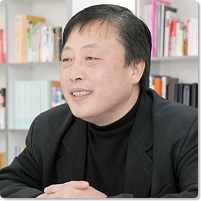
Cho Kyung-Hwan
Born 1961. Graduated from Chungang University and graduate school with a major in comparative film history. Became the director of director of the Yongan Hall (present Doosan Art Center) at the age of 33, after which he continued to work in theater management as head of performance planning teams at the National Theater of Korea (2000-01) and the Ansan Arts Center (2004-09). He also served as administrative director of the Gwacheon Hanmadang Festival (2003-04). In 2009, Cho was appointed director of the Bupyeong Arts Center. He has also been active in academia as an instructor in film and arts management at several institutions including the media design department of the graduate school of Hanyang University, the performance planning/management department of Chungwoon University and the departments of broadcasting, film and arts management at Kangwon National University. Presently, he also serves as advisor and instructor of the Goyang City Youth Center.
*1
Calculated at the August 2010 exchange rate. The same rate is used for all subsequent figures involving the S. Korean won.
*2
A system under which the national government, provincial governors or municipality mayors can designate national and public arts companies, organizations contracted to run national and public theaters and outstanding private sector operated professional arts companies as a “Special Arts Company” or a “Special Arts Organization.” Since its adoption in 2000, 415 companies and organizations have received this designation.
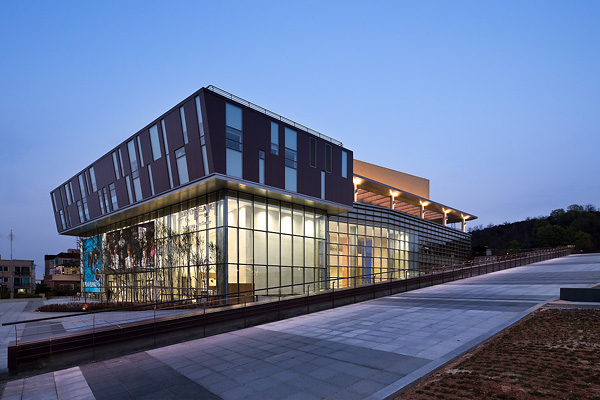
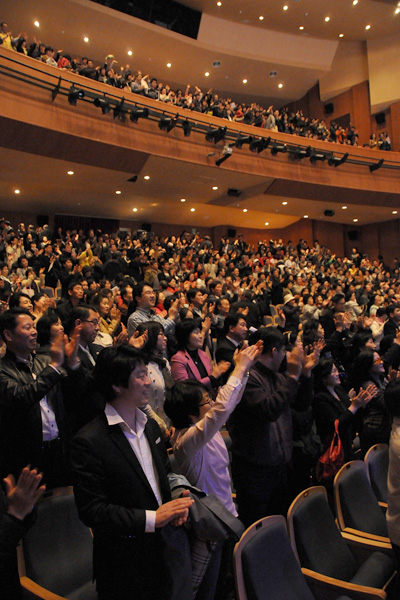
Bupyeong Arts Center
Opened April 2010. Facilities include the Hae-Nu-Ri (Sun) 893-seat large theater, the Dal-Nu-Ri (Moon) 339-seat theater, the rooftop outdoor performance hall Byeol-Nu-Ri (Star), the Kot-Nu-Ri (Flower) gallery space, the Community Hall HoBAC, studio and seminar rooms, a children’s playroom, etc. In October an artist residence facility “Artist Village” will open.
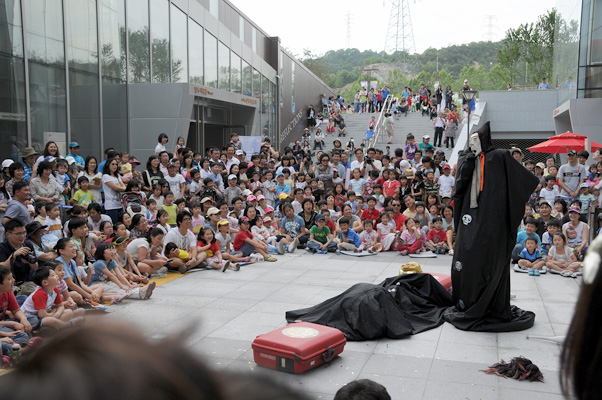
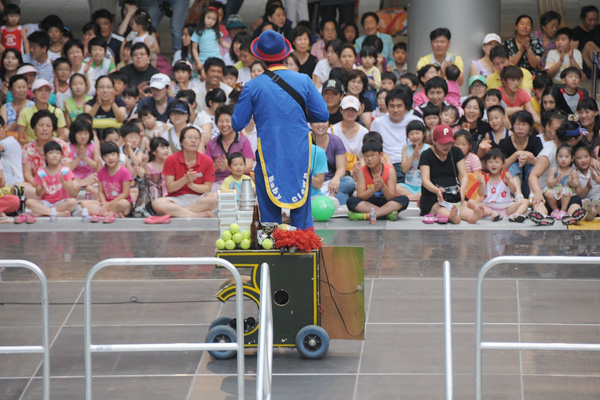
At the free-admission opening festival “Street! Let’s Play”
(Jul. 2010)
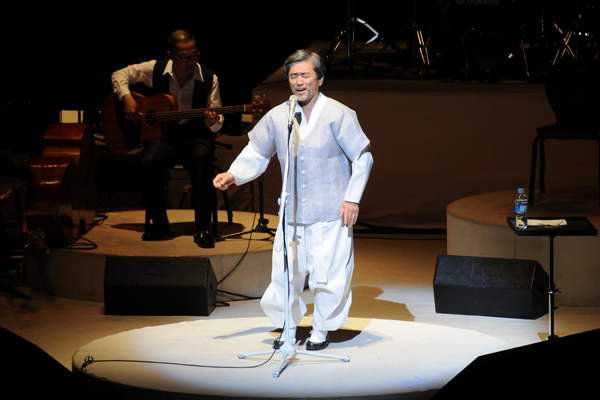
One of the opening commemorative performances, the “Jang Sa-ik Concert: Warm Spring Day, Flower Viewing”
Related Tags

